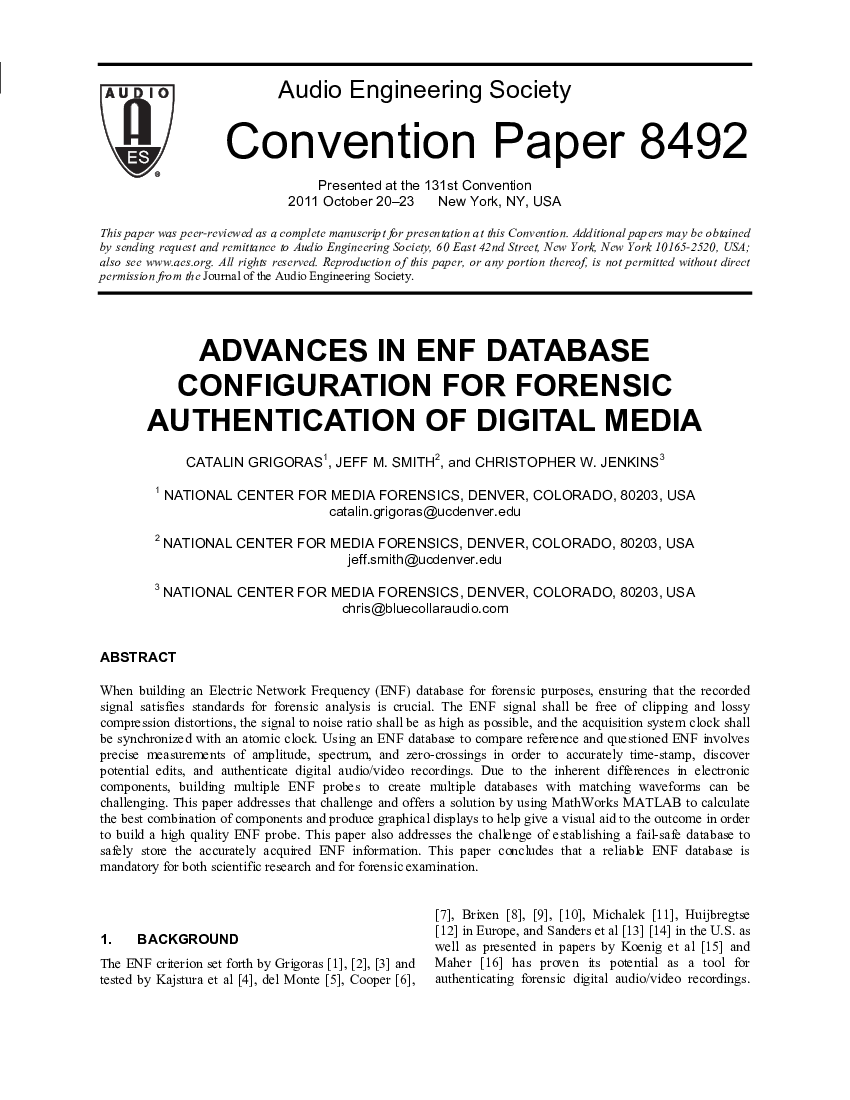Home / Publications / E-library page
You are currently logged in as an
Institutional Subscriber.
If you would like to logout,
please click on the button below.
Home / Publications / E-library page
Only AES members and Institutional Journal Subscribers can download
When building an Electric Network Frequency (ENF) database for forensic purposes, ensuring that the recorded signal satisfies standards for forensic analysis is crucial. The ENF signal shall be free of clipping and lossy compression distortions, the signal to noise ratio shall be as high as possible, and the acquisition system clock shall be synchronized with an atomic clock. Using an ENF database to compare reference and questioned ENF involves precise measurements of amplitude, spectrum, and zero-crossings in order to accurately time-stamp, discover potential edits, and authenticate digital audio/video recordings. Due to the inherent differences in electronic components, building multiple ENF probes to create multiple databases with matching waveforms can be challenging. This paper addresses that challenge and offers a solution by using MathWorks MATLAB to calculate the best combination of components and produce graphical displays to help give a visual aid to the outcome in order to build a high quality ENF probe. This paper also addresses the challenge of establishing a fail-safe database to safely store the accurately acquired ENF information. This paper concludes that a reliable ENF database is mandatory for both scientific research and for forensic examination.
Author (s): Grigoras, Catalin; Smith, Jeffrey; Jenkins, Christopher
Affiliation:
University of Colorado Denver, Denver, CO, USA
(See document for exact affiliation information.)
AES Convention: 131
Paper Number:8492
Publication Date:
2011-10-06
Import into BibTeX
Session subject:
Applications in Audio
Permalink: https://aes2.org/publications/elibrary-page/?id=16018
(678KB)
Click to purchase paper as a non-member or login as an AES member. If your company or school subscribes to the E-Library then switch to the institutional version. If you are not an AES member Join the AES. If you need to check your member status, login to the Member Portal.

Grigoras, Catalin; Smith, Jeffrey; Jenkins, Christopher; 2011; Advances in ENF Database Configuration for Forensic Authentication of Digital Media [PDF]; University of Colorado Denver, Denver, CO, USA; Paper 8492; Available from: https://aes2.org/publications/elibrary-page/?id=16018
Grigoras, Catalin; Smith, Jeffrey; Jenkins, Christopher; Advances in ENF Database Configuration for Forensic Authentication of Digital Media [PDF]; University of Colorado Denver, Denver, CO, USA; Paper 8492; 2011 Available: https://aes2.org/publications/elibrary-page/?id=16018
@article{grigoras2011advances,
author={grigoras catalin and smith jeffrey and jenkins christopher},
journal={journal of the audio engineering society},
title={advances in enf database configuration for forensic authentication of digital media},
year={2011},
number={8492},
month={october},}